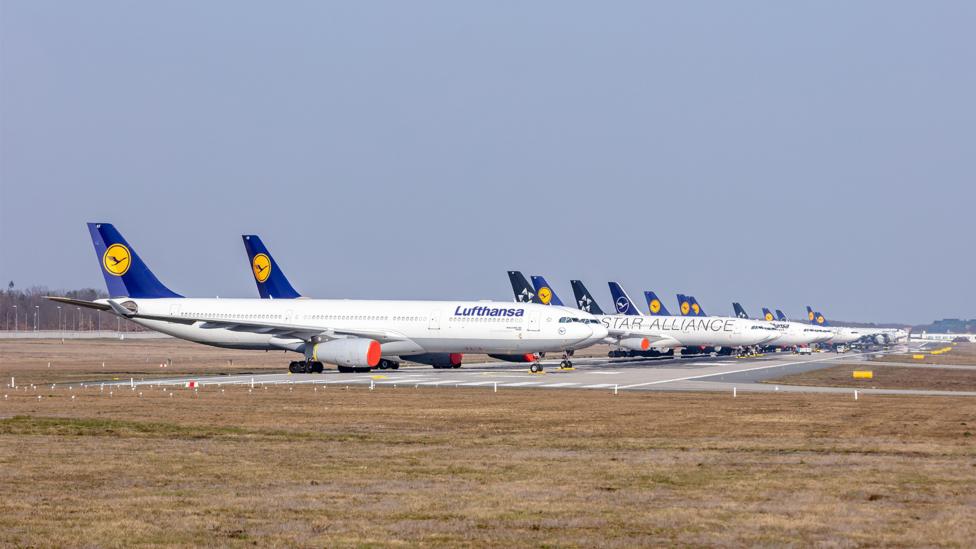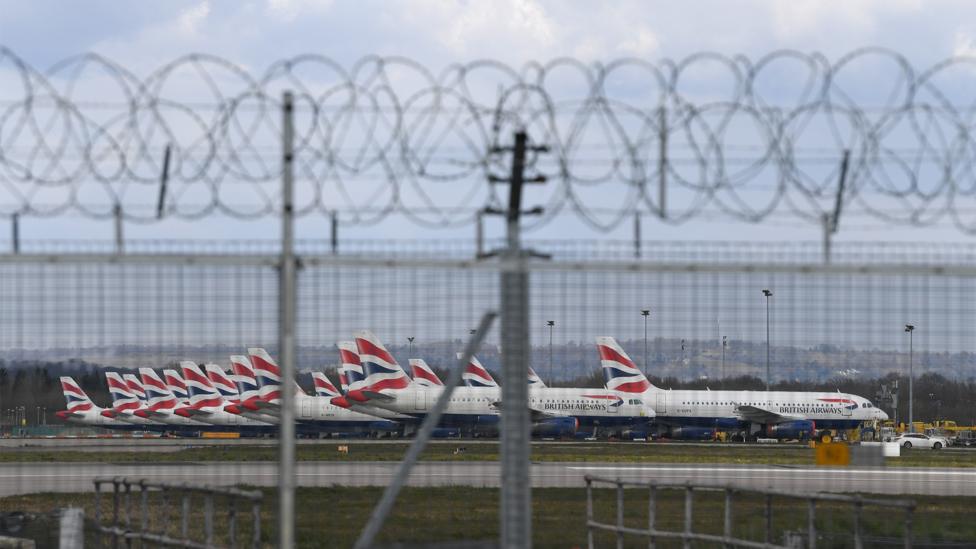Between a third and half of the global population are in some form of lockdown. City centres, malls, high streets and tourist attractions are all quiet – and so too is the sky above our planet. The planes that connect our world, unite families and open our eyes to new horizons are, almost entirely, grounded.
“In March, we’d typically expect to see between 175,000 and 180,000 total flights per day,” explains Ian Petchenik from flight tracking website FlightRadar24. “At any one time that’s generally between 10,000 and 15,000 flights. Those numbers have fallen significantly to just 64,522 flights tracked on 29 March.”
Most planes that would ordinarily be in the air are currently on the tarmac. And on top of the multitude of economic and logistical problems this poses for airlines, employees and passengers, there’s another issue to consider: where can airlines store these grounded aircraft?
The answer, say experts, is a mixed picture that depends on where your hubs are, the kind of aircraft you fly and the engineering capacity in place to mothball the aircraft (deactivating and storing it) and get them back up and running when this current crisis is over.

Hubs and boneyards
As a rule, airline economics dictate that planes should be used as much as possible. For larger planes used for long-haul flights, this means keeping them flying as close to 24/7 as possible. If you’re an airline flying a big 400-seater Boeing 777, for example, you’ll ideally have it at your home airport for only as long as it takes to get passengers and cargo off and on, refuel, clean, load catering and depart.
The upshot of that is that there simply isn’t enough space at most global hub airports — the ones where major international airlines connect their regional and intercontinental passengers, like Dubai, New York JFK, London Heathrow and so on — to park all the planes that are notionally based there. Those planes aren’t normally all there at the same time. As a result, aircraft are being parked in a variety of places.
“Some airlines are using dedicated storage facilities,” Petchenik explains. Southwest and Delta Air Lines, he says, are storing over 50 aircraft each at Victorville, a former US air base in California that now serves as a logistics hub for business, military and freight aviation, and also a ‘desert boneyard’ famous for its lines and lines of mothballed aircraft.
Delta also has over 80 aircraft stored in each of Marana, Arizona, another boneyard, and Birmingham, Alabama, both in the US, Petchenik says. “United Airlines and American Airlines are each storing aircraft at their hub airports, with over 40 United aircraft stored in Houston (IAH, the city’s main airport). American, in addition to its hub storage, has aircraft parked in Tulsa and Pittsburgh [in the US states of Oklahoma and Pennsylvania, respectively].”
Larger airlines are clustering similar aircraft together; some need certain maintenance, and having engineers who specialise in those types of planes in the same place makes sense. American Airlines, for example, is using four airports: its Airbus A320, A321 and A330 aircraft, as well as Embraer E-190 regional jets, are parked in Pittsburgh, the airport that used to be a hub for US Airways (which merged with American in 2015) but which has had extra space to offer since.

Tulsa is the temporary home for many of American’s Boeing aircraft: the already-grounded 737 MAX, plus the 757, 777 and 787. But Tulsa is bang in the middle of ‘Tornado Alley’ and indeed, a severe thunderstorm passed through the area in late March. Planes are strengthened against hail hitting them from the front when they’re flying, but less so from above when they’re parked, so any damage will be an expensive proposition.
Mobile in Alabama — where Airbus has a factory — has American’s A321 and 777 aircraft parked. Roswell, in the US state of New Mexico (best known for a more interplanetary kind of visitor), is now temporary home to Boeing 737, 757, 767 and 777 aircraft. It’s another of the famous aircraft boneyards, where planes are stored long-term before eventually either being reactivated, stripped for parts, recycled or a combination of the three. The airport used to be a major US Air Force base during the Cold War and has had space to spare since the base’s closure.
Like any airport parking lot, the rates an airline pays to park its planes depend on how convenient the location is. Space at larger and more important airports tends to be more expensive, and is also limited, which is why airlines are flying their planes to out-of-the-way places. Airlines have to make hard decisions about whether it’s better to keep planes closer to hand, making restart easier but costing more in parking fees, or whether to take the cheaper parking space that’s a lot farther away.
Runway parking
In Europe, some airlines have grounded their entire fleets, while others are keeping a few key aircraft ready to perform repatriation flights, fly critical medical and other cargo around the world, or as otherwise agreed with their national governments. When it comes to storage, a similar patchwork of solutions is in place.
Low-cost carrier easyJet, for example, has a dispersed hub structure, so has parked its 344 aircraft across 30 airports in its network. Since it mostly operates short-haul flights between non-hub airports, easyJet’s point-to-point network means that it is used to finding a variety of places around Europe for its aircraft to spend the night.

Since Europe doesn’t have the space or ultra-dry desert climates for boneyards, airlines are parking their aircraft at a variety of different airports. “British Airways has nearly 40 aircraft at Bournemouth,” says Petchenik. “Others, like Lufthansa, are parking aircraft on now-unused runways and in unused areas of the airport.”
“In total, 700 out of 763 Lufthansa Group aircraft are parked,” says Lufthansa spokesperson Neda Jaafari. That number doesn’t just contain Lufthansa’s planes with the signature crane on the tail: it’s the members of its corporate family, which includes Austrian, Brussels Airlines, Eurowings and Swiss.
At Frankfurt airport, one of Europe’s busiest and most important hub airports, one of the four runways (and the taxiways leading to and from it) is now home to dozens of aircraft. Most of Lufthansa’s planes are parked there, in Munich (Lufthansa’s second primary hub) and Berlin, says Jaafari. “We have planned [to position] most of our aircraft at the hubs to ensure that they can be reactivated on site and returned to operations at any time: for example, at Berlin Schönefeld Airport, where Lufthansa Technik is based.”
Lufthansa Technik is the German airline’s MRO — maintenance, repair and overhaul — operator. Not all airlines keep this sort of work in-house, with many outsourcing to other airlines or third-party companies, so it will be interesting to see whether this gives some airlines an advantage in keeping their planes ready for the recovery.
Caring for aircraft
What you have to do to a parked aircraft depends on how long you expect it to be on the ground, says Jaafari. “For example, there are clear specifications from aircraft manufacturers as to what needs to be done for short-term parking in regards to a few days or even up to months. For an A320 [a short- to medium-haul plane that usually flies routes of between one and five hours, carrying up to 186 passengers], for example, this means covering the engines and sensors, draining liquids (oil, water and kerosene), disconnecting the power supply and batteries.”

Depending on the weather conditions more work may then be added in, like protecting aircraft against frost or strong winds. “In case of longer periods of inactivity, additional measures may be necessary, such as masking windows and doors. And if we do not have enough engine covers, the engines can alternatively be protected with foil.”
Parked aircraft, Jaafari notes, need to be checked regularly, usually once a week, by qualified mechanics to ensure that there is no damage. As a rule, she says, it takes some 60 working hours to mothball an Airbus A320, and should take about the same time to bring one back into service.
Though the timescale will be slightly different for each aircraft, what that means is that relaunching the global commercial air fleet will have to be a staggered process, rather than an immediate spike back to the way things were — and some planes may not return at all.
Retiring older aircraft
Demand is expected to return slowly once the coronavirus crisis starts to diminish. That means, however, that airlines are having to make hard choices about their fleets.
The Boeing 747, perhaps the most iconic commercial aircraft of all time, has already been retired by many airlines, but both Dutch airline KLM and Australia’s Qantas have brought forward their jumbo jets’ retirement. These older planes were on the way out over the next few years, and keeping the few remaining aircraft in working order when they probably won’t be needed doesn’t make economic sense.
Virgin Atlantic, too, has retired its Airbus A340-600; this large four-engine passenger plane couldn’t compete on efficiency with newer aircraft with two more efficient jets, and with dropping demand it won’t fly again for the airline.
Some airlines, too, may bring forward retirements of the Boeing 757, a medium-sized plane that is used for a variety of missions but has a useful niche of flying about 150 passengers around seven hours. This niche serves lower demand flights from the eastern US to western and central Europe, and if the 757 doesn’t return (or doesn’t return in sufficient numbers) these routes may have to wait until the first deliveries of the Airbus A321XLR, the new generation aircraft that is planned to replace the 757 by most airlines.
With uncertainty about when it will be safe to lift the world’s lockdowns, however, there’s equal uncertainty about how many of those planes will be needed during the recovery phase, and how quickly. Demand is still, in many places, rock-bottom: earlier this month, on 2 April, just 349 people left Hong Kong Airport. Those people could easily fit on one Cathay Pacific plane, with room to spare.
— BBC



